QR or quick response are a type of 2D barcode that can encode detailed product information in a compact space. While the industry is now transitioning to 2D barcodes to satiate customer hunger for accurate and more accurate information.
Also known as matrix barcodes, they are types of barcodes that store information in two dimensions — both horizontally and vertically — unlike traditional 1D barcodes, which store data in only one direction (typically horizontally).
The importance of GS1 QR codes
A GS1 QR Code is a standardised 2D barcode developed and regulated by GS1, a global organisation that sets standards for business communication, including barcoding.
It is a specific type of QR Code designed to encode structured data using GS1 standards, such as GTINs (Global Trade Item Numbers), batch/lot numbers, expiry dates, and other product-related information.
- Governing Body: The GS1 system is managed by GS1, a not-for-profit organisation operating in over 100 countries.
- Human- and Machine-Readable: GS1 QR Codes allow for seamless interoperability between human-facing and machine-facing systems.
- Error Correction: Unlike traditional barcodes, GS1 QR Codes can be read omnidirectionally, without losing critical data.
- International Standards Compliance: Follows ISO/IEC 18004 for QR Code structure and GS1 General Specifications for data formatting.
Difference between a traditional barcode and a GS1 QR code
| Feature | GS1 1D Barcode | GS1 2D Barcode |
| Type | Linear barcode | Matrix (2D) barcode |
| Examples | UPC-A, EAN-13, GS1-128 | GS1 DataMatrix, GS1 QR Code, GS1 Digital Link QR |
| Data Capacity | Limited (typically one identifier like GTIN) | High — can include GTIN, batch/lot, expiration, etc. |
| Physical Size | Longer, linear format — grows with more data | Compact — stores more in less space |
| Error Correction | None or minimal | Built-in error correction (e.g., Reed-Solomon) |
| Scanning Technology | Laser scanners | Imager/camera-based scanners |
| Typical Use Cases | Retail point of sale (POS), shelf labels | Pharmaceuticals, medical devices, fresh food, traceability, eReceipts |
| POS Readability | Standard for retail POS | Becoming the new standard for POS |
| Compliance & Standards | GS1 General Specifications (Linear symbologies) | GS1 General Specifications (2D symbologies) |
Benefits of GS1 QR Code
Improved Product Traceability:
GS1 QR codes carry standardised identifiers that allow businesses to track products throughout the supply chain—from production to the end consumer—enabling faster recalls, better transparency, and compliance with regulatory requirements.
Enhanced Consumer Engagement:
Consumers can scan GS1 QR codes to instantly access trusted product information such as origin, ingredients, certifications, and authenticity, fostering transparency and stronger brand engagement.
Improved Supply Chain Efficiency:
By enabling quick and accurate data capture, GS1 QR codes streamline logistics, inventory management, and order processing, reducing errors and boosting supply chain responsiveness.
Data Integrity and Accuracy:
GS1 QR codes ensure consistent and reliable product data through global standards, minimising manual input errors and supporting trusted data exchange across systems and partners.
Conclusion
GS1 QR codes play a vital role in the modern supply chain by enabling accurate product traceability, streamlining operations, and enhancing consumer trust through instant access to reliable information. As the demand for transparency and efficiency grows, businesses are encouraged to adopt GS1 QR codes to stay competitive, meet regulatory standards, and deliver a better experience for both partners and customers.


